One in four companies currently uses automation or Artificial Intelligence to support hiring, and this proportion increases in larger organisations. In businesses with over 5,000 employees, the proportion using AI rises to 42%
The launch of OpenAI’s ChatGPT has raised the profile of Artificial Intelligence (AI) tools, prompting many executives to question how this latest leap forward in technology can be used across every aspect of a business.
Whilst many HR teams have already integrated systems that allow repetitive admin tasks to be automated, AI has opened up new possibilities to bring further efficiencies and benefits to busy HR professionals and their organisations.
This is no distant prospect; a Guardian report in March 2023 found that one-third of Australian businesses currently use AI tools in recruitment and a Mercer report in 2020 found that 55% of HR leaders were already using predictive algorithms in hiring.
As HR teams look to the future, 50% anticipate that their organisation will struggle to meet demand with their current talent model. Meanwhile, 56% of HR leaders say their hiring volume will increase this year, but 66% say recruiting teams will stay the same size or contract. With 52% of talent acquisition leaders agreeing the most challenging part of recruitment is identifying suitable candidates from a large applicant pool, the potential use case for AI in talent acquisition is clear to see.
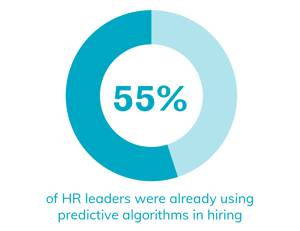
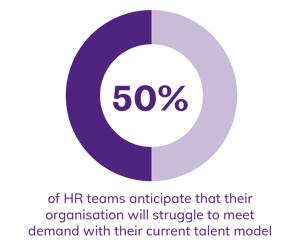
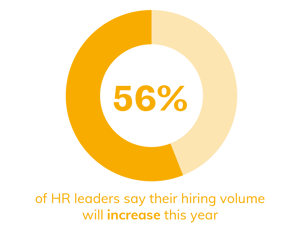
Artificial Intelligence is often misunderstood and confused with simpler automation technologies. It’s important to understand the different aspects of these technologies and their applications to understand both the possibilities and our stage on the implementation journey.
AI applies analysis and logic techniques, including Machine Learning, to interpret events, support and automate events and take decisions.
Example HR use case:
Screening applications based on a job description using all available data to recommend suitable candidates.
Follows a set of predefined rules to carry out actions. It follows the format of if x action happens, do y.
Example HR use case:
Sending reminder emails and surveys.
Machine Learning is a part of AI. It describes learning from past data to improve answers and predictions.
Example HR use case:
Analysing past and current employee performance to predict similar applicants' performance in role.
NLP can also be used as part of AI. This technology can understand and analyse conversational language for sentiment and accuracy.
Example HR use case:
Evaluating applications and screening calls.
Traditional chatbots are trained via Machine Learning to recognise and respond to questions. This can often be simplistic, using basic questions and answers, or advanced, using conversational flows and pulling data from other systems. AI-powered chatbots can learn from previous conversations to improve without human input.
Example HR use case:
Applicant information bot
Generative AI uses existing information to create entirely new content. This could be in any format, from copy and imagery to audio, video and presentations.
Example HR use case:
Creating job descriptions and adverts
We are still at the beginning of AI development and implementation. Familiar technologies, including automation, Machine Learning and Natural Language Processing, are already integrated into existing systems and part of the business toolkit. As AI develops, we will repeat the cycle of technological breakthroughs followed by a proliferation of tools, then rationalisation and integration. AI experts call our current phase ‘Narrow AI’ as it is focused on achieving a specific outcome or working to a specific brief, and it has defined parameters on where it can learn from.
Many HR teams have implemented technology such as Applicant Tracking Systems (ATS) and Candidate Relationship Management systems (CRM) to automate manual processes and maintain contact with candidates throughout the application journey. Now AI provides new opportunities to support teams, improving efficiency and hiring speed.
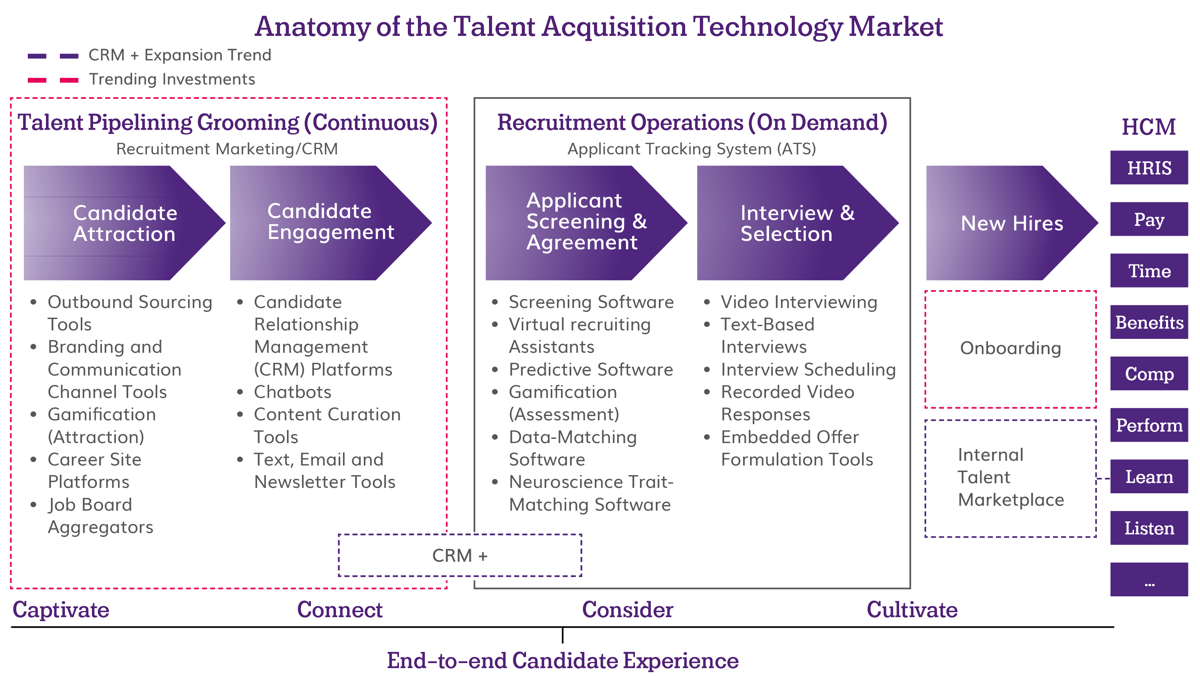
The AI tools that are currently available can help HR professionals in various ways, including:
Generative AI tools like ChatGPT can write full job descriptions from just a few prompts, screen adverts for biased language, and suggest new ways of advertising to broaden the talent you can attract.
AI tools can screen CVs to provide you with a shortlist based on your criteria. They can even schedule, run and screen virtual interviews, effectively allowing you to interview every candidate.
AI can scan available market data and provide dynamic offer recommendations based on location, salary and role.
AI chatbots provide a new automated way for employers to stay in contact with candidates throughout the journey. This is important, both to maintain a positive impression and engage prospective employees to prevent dropout during the process.
Want to read this offline or share with a colleague? Simply fill in some details to download a copy.
AI has the potential to bring huge benefits to both recruiters and prospective employees. In a recent survey, 47% of Americans agreed that AI would do a better job than humans when it comes to evaluating all job applicants in the same way.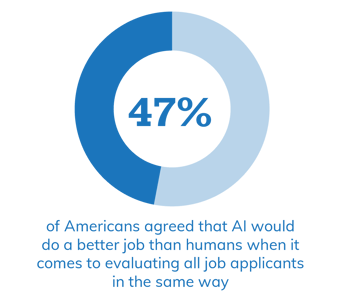
The benefits for business:
Time is saved in the early stages of recruitment on tasks such as sifting, screening and scheduling. Automating these tasks allows HR professionals to focus on time with people rather than processes.
Researchers from the London School of Economics found that AI hiring improves efficiency in hiring by being faster, increasing the fill rate for open positions, and recommending candidates with a greater likelihood of being hired after an interview. This provides a better candidate experience and reduces the time a seat remains empty, improving productivity.
Personal preferences and unconscious bias can easily become a part of the recruitment process. AI has the potential to remove this from the equation. The LSE study also assessed whether AI could reduce bias and improve the diversity of selected candidates. Overall, AI hiring resulted in more diverse outcomes than human hiring.
AI screening raises the quality of the match between employer and candidate, which leads to better retention.
AI chatbots can be used to answer candidate questions and keep candidates up to date throughout the process, maintaining engagement and reducing the risk of dropout.
A basic but important point, AI removes the possibility of human error.
Dr Grace Lordan, Associate Professor in Behavioural Science at LSE and Founding Director of The Inclusion Initiative
Although there are many benefits for employers, businesses must also consider the candidate's experience.
In a recent study by Pew Research, the vast majority of respondents were unaware that AI was being used in the hiring process, and two-thirds said they would not want to apply for a position if they knew AI was used to help make hiring decisions. The same study found that people strongly opposed AI making the final hiring decision by a ten-to-one ratio. Moreover, they are more sceptical that AI would be an improvement over humans when it comes to thinking outside the box; 44% said AI would do a worse job when it comes to seeing potential in job applicants who may not perfectly fit the job description.
Research from the London School of Economics backs up this negative response to using AI in hiring. The main reasons for this negative view were privacy concerns and a less personable, more robotic experience. Overall, organisations that deploy AI hiring were seen as less attractive than those hiring through humans.
Employers can address these concerns by being transparent about how and why they use AI in hiring. They can also use this opportunity to discuss how it can benefit candidates through improved communication, shortened hiring time, and reduced bias.
As with any new technical implementation, there are challenges in onboarding and integrating a new piece of software alongside existing systems. Companies must also allocate time and resources to training the tool using existing data sets.
AI technology is often enterprise software aimed at large organisations without transparent pricing. Businesses will need to research available technology options or use specialist technology consultants to advise on the various options.
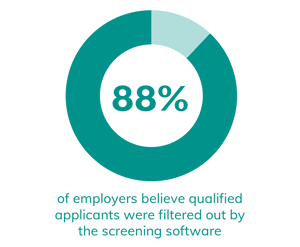 Research by Harvard Business School found that 88% of employers believe qualified applicants were filtered out by the screening software. There are multiple reasons why this could happen, such as missing keywords on applications, gaps in work history being viewed negatively by technology and bias based on a lack of previous performance data for similar candidates. Providing a bloated job description could also lead to qualified candidates being missed as the shortlisting criteria become too extensive.
Research by Harvard Business School found that 88% of employers believe qualified applicants were filtered out by the screening software. There are multiple reasons why this could happen, such as missing keywords on applications, gaps in work history being viewed negatively by technology and bias based on a lack of previous performance data for similar candidates. Providing a bloated job description could also lead to qualified candidates being missed as the shortlisting criteria become too extensive.
Multiple studies cast doubt on some applications of AI. An NYU study of two AI platforms found significant variances in outcome based on resume format and the presence of LinkedIn URLs. There are also concerns about the evidence behind video screening techniques based on expression and tone of voice analysis. Independent researchers from the University of Cambridge’s Centre for Gender Studies created a tool which showcases how a simple thing like lighting can impact the results of these assessments.
As with any tool, AI can only perform to the level of the data it can access. For example, features such as dynamic salary offers will be limited by the openness of market data which may make the granularity of specific locations and roles unreliable.
As AI uses predictive analysis: to infer future performance, it could perpetuate existing bias. For example, AI, trained on data showing a pattern of promoting men with an Ivy League college degree, could read this as a predictor of success and prioritise those applications above those of women or those with a different educational path but relevant experience.
An example of how this bias can manifest is shown in US research conducted in 2020 which found that facial-analysis technology created by Microsoft and IBM, among others, performed better on lighter-skinned subjects and men.
This example cited in the Guardian is a reminder of how crucial it is to be mindful of how AI tools are trained:
In 2017, Amazon quietly scrapped an experimental candidate-ranking tool that had been trained on CVs from the mostly male tech industry, effectively teaching itself that male candidates were preferable. The tool systematically downgraded women’s CVs, penalising those that included phrases such as “women’s chess club captain”, and elevating those that used verbs more commonly found on male engineers’ CVs, such as “executed” and “captured”.
Want to read this offline or share with a colleague? Simply fill in some details to download a copy.
AI has enormous potential to improve efficiency and effectiveness in Talent Acquisition. In the future, AI will not only screen applications but also be able to identify potential candidates that have the requisite skills and qualifications but have yet to apply for the role. The predictive analysis within AI can predict success in a role using candidate data and even social media profiles and online behaviour. We also have the opportunity to use AI to create a more personalised experience for candidates and apply this to employees. However, with these new possibilities come new risks, not least in privacy, data protection, ethical use and potential for bias.
AI is currently in a ‘hype’ phase with huge interest driven by the breakthrough of ChatGPT. However, many legal and ethical considerations remain; in content and data ownership, learned bias through existing data, and selection of source material. Given these risks, there’s little doubt that regulation will come into play, as has already happened in New York City.
As the technology advances and matures, we will see more guidance and best practices developed to allow businesses to make the best use of its functionality. Integration into existing HR tools and more affordable and scalable options will soon follow the proliferation of stand-alone tools. We will likely see a second wave of deeper AI tools as we expand the ways we use AI and begin to think more widely and deeply about its application over time.
That said, there are still gains to be made by using AI today. AI has already been proven to speed up the recruitment process, providing benefits for employers and candidates. The challenge for businesses is in the data used to train AI and monitoring tools closely for any unintended bias generated due to this data set. Companies also face the challenge of understanding the technology and verifying vendor claims as they search for prospective solutions.
While AI can provide many efficiencies, the implementation of AI is not to be taken lightly. Leaders should consider the limitations of their own and publicly available data when assessing the benefits of an AI-driven approach. There’s no doubt there are huge efficiencies to be gained, particularly for organisations facing huge volumes of applications. Still, many concerns will need to be addressed throughout the implementation process.
No, at least not yet! AI has a long way to go before it reaches human-like capacity. Experts define this stage as narrow AI, where we must provide a clear brief and point the technology towards data that can help provide a solution. AI can’t undertake original research and has yet to be proven to analyse an interview reliably.
However, certain aspects can help overstretched teams, especially in the screening and sifting phase of recruitment.
Small businesses can benefit from using generative AI tools such as Chat GPT to create job descriptions and adverts and suggest avenues to advertise to widen the reach of the role. Businesses that have implemented ATS and CRM systems to help with recruitment should speak to their current providers about AI use within their tool, as there may be features that aren’t being utilised.
Yes, but AI use in recruitment needs to be carefully considered. Employers must validate the claims made by vendors concerning ethics and bias and be transparent with candidates on how and why AI is used in the recruitment process.
AI can remove the potential for bias through its ability to apply the same criteria equally across all applications. However, there are risks in how AI is briefed and the data it is trained on, which can lead to AI mimicking existing bias or replicating the current diversity as it attempts to predict future performance based on the current make-up of an organisation.
As AI technology is in its early stages, there are several risks, including legal risks around ownership and copyright of publicly available data, privacy and data protection concerns from prospective candidates, and ethical concerns around fairness and equality in the recruitment process.
Leverage Talent Intelligence by using data-driven insights to anticipate talent needs, understand workforce capabilities, and predict future skills trends, enabling strategic decisions to meet business objectives and outpace competition.
© Talent Insight Group 2025